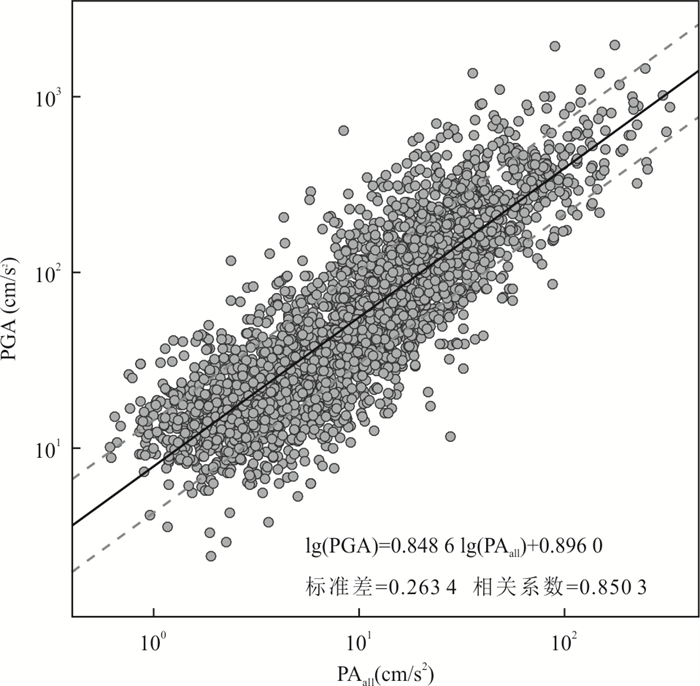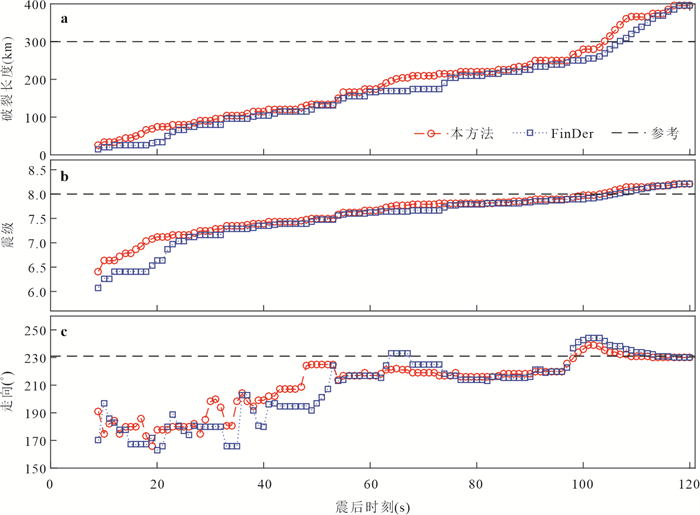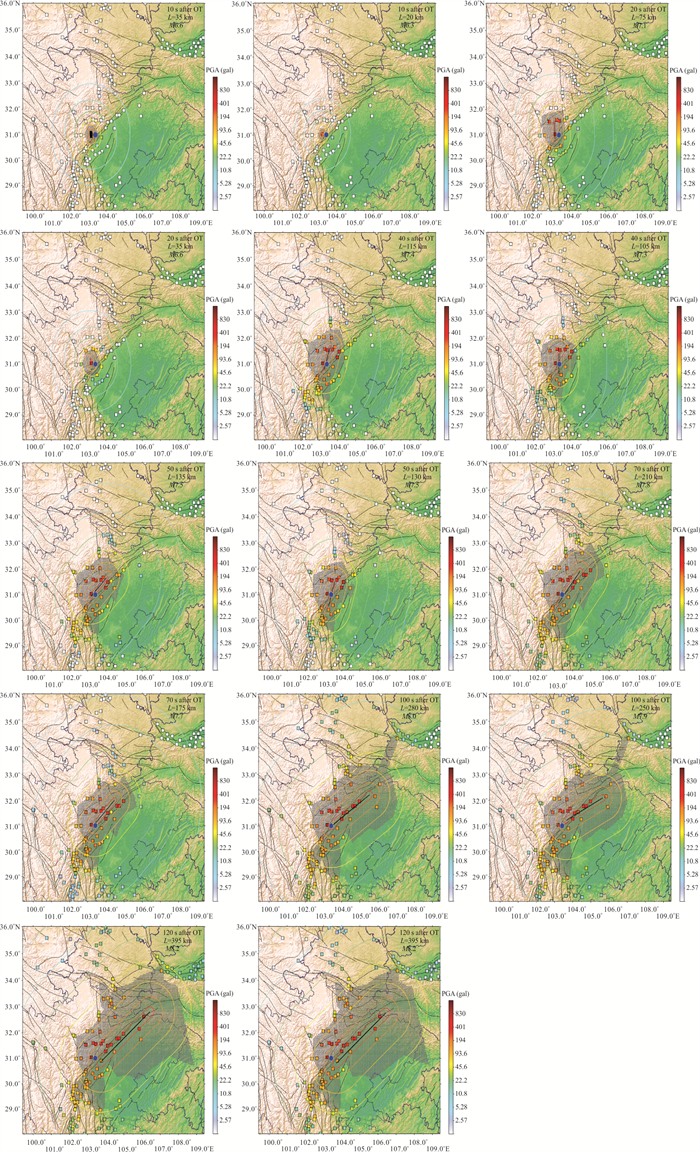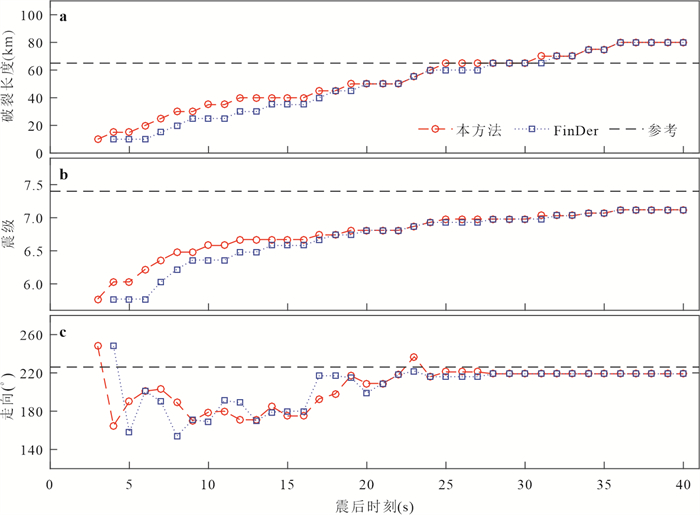Real-Time Continuous Estimation of Seismic Source Rupture Characteristics Considering P-Wave Early Warning Parameters
-
摘要: 在地震预警系统中引入震源破裂特征实时持续估测方法,可有效克服传统基于点源模型估测目标预警烈度和潜在破坏区的不足. 现有方法的实时性通常只能达到分钟级,无法满足地震预警系统的高时效性要求. 基于地震台站实时观测数据,通过引入地震预警P波特征参数,开展有限破裂模板匹配技术研究,形成了一套时效性更强的震源破裂特征实时估测方法. 测试结果表明:利用本方法在震后同一时刻得到的结果相对于有限破裂探测器(FinDer)算法结果在速度上要快3 s左右,个别震例结果要快5 s;破裂初期,由于受到地震辐射多样性、场地、传播路径等因素的影响,走向θ会存在较大的波动. 随着破裂的延展,θ逐渐收敛至参考值;对于M7.0级以下地震,震后6~10 s即可获得较稳定的破裂特征参数结果,而对于M7.0+地震,则需要更长的时间,尤其是类似于汶川8.0级这种特大地震,其结果在台网较为稀疏的情况下需到震后40 s才能逐渐稳定.Abstract: By introducing the real-time estimation method of seismic source rupture characteristics in to an earthquake early warning system (EEWS), we can effectively overcome the shortcomings of the traditional point-source-model-based estimation of target warning intensity and potential damage zones, and improve the disaster mitigation effectiveness of an EEWS. The real-time performance of existing methods is usually only at the minute level, which cannot meet the high timeliness requirements of EEWSs. In this work, we developed a real-time method to continuously estimate source rupture characteristics considering P-wave warning parameters. This method is an improvement of the finite rupture template matching method, namely FinDer. The system test results show that the results obtained using this method are about 3 s faster compared to the FinDer algorithm results at the same moment after the earthquake, and the results of individual earthquake cases are 5 s faster. Additionally, at the early stage of rupture, there are large fluctuations in the obtained strike θ due to the influence of seismic radiation diversity, site, propagation path and other factors. As the rupture continues, θ will gradually converge to the reference value. Moreover, for earthquakes of magnitude less than M7.0, relatively stable rupture characteristic parameter results can be obtained 6-10 s after the earthquake origin, while for M7.0+ earthquakes, it takes longer time, especially for mega-earthquakes such as the Wenchuan M8.0 event, whose results need to be gradually stabilized only at 40 s after the origin with relatively sparse station coverage.
-
图 1 全P波段垂直向加速度预警参数PAall与PGA的拟合曲线(彭朝勇等,2021)
Fig. 1. Fitting curve of the vertical acceleration early-warning parameter PAall obtained from the full P wave window with PGA(Peng et al., 2021)
表 1 线下模拟所用4次破坏性地震事件信息
Table 1. The four damaging earthquakes used for off-line simulation
事件名 发震时刻 震中经度
(ºN)震中纬度
(ºE)深度
(km)震级
Ms走向θ
(º)破裂长度L(km) 四川汶川地震 2008-05-12
14∶28∶00103.42 31.01 14 8.0 231/51 290 四川芦山地震 2013-04-20
08∶02∶48102.99 30.30 17 7.0 218/38 40 青海门源地震 2022-01-08
01∶45∶28101.26 37.77 10 6.9 284/104 31 日本熊本地震 2016-04-16
01∶25∶17130.76 32.75 12 7.4 226/46 65 -
Allen, R. M., Melgar, D., 2019. Earthquake Early Warning: Advances, Scientific Challenges, and Societal Needs. Annual Review of Earth and Planetary Sciences, 47(1): 361-388. https://doi.org/10.1146/annurev-earth-053018-060457 Böse, M., 2006. Earthquake Early Warning for Istanbul using Artificial Neural Networks(Dissertation). Karlsruhe University, Karlsruhe, 19-24. Böse, M., Heaton, T. H., Hauksson, E., 2012. Real-Time Finite Fault Rupture Detector (FinDer) for Large Earthquakes. Geophysical Journal International, 191(2): 803-812. https://doi.org/10.1111/j.1365-246X.2012.05657.x Böse, M., Smith, D. E., Felizardo, C., et al., 2018. FinDer v. 2: Improved Real-Time Ground-Motion Predictions for M2-M9 with Seismic Finite-Source Characterization. Geophysical Journal International, 212(1): 725-742. https://doi.org/10.1093/gji/ggx430 Böse, M., Andrews, J., Hartog, R., et al., 2023. Performance and Next-Generation Development of the Finite-Fault Rupture Detector (FinDer) within the United States West Coast ShakeAlertWarning System. Bulletin of the Seismological Society of America, 113(2): 648-663. https://doi.org/10.1785/0120220183 Cheng, J., Rong, Y. F., Magistrale, H., et al., 2020. Earthquake Rupture Scaling Relations for Mainland China. Seismological Research Letters, 91(1): 248-261. https://doi.org/10.1785/0220190129 Chung, A. I., Meier, M. A., Andrews, J., et al., 2020. ShakeAlertEarthquake Early Warning System Performance during the 2019 Ridgecrest Earthquake Sequence. Bulletin of the Seismological Society of America, 110(4): 1904-1923. https://doi.org/10.1785/0120200032 Cui, P., Wang, J., Wang, H., et al., 2022. How to Scientifically Prevent, Manage and Prewarn Catastrophic Risk?. Earth Science, 47(10): 3897-3899 (in Chinese with English abstract). Fang, L. H., Wu, J. P., Wang, W. L., et al., 2013. Relocation of the Mainshock and Aftershock Sequences of MS7.0 Sichuan Lushan Earthquake. Chinese Science Bulletin, 58: 3451-3459. https://doi.org/10.1007/s11434-013-6000-2 Hoshiba, M., Iwakiri, K., Hayashimoto, N., et al., 2011. Outline of the 2011 off the Pacific Coast of Tohoku Earthquake (MW 9.0): Earthquake Early Warning and Observed Seismic Intensity. Earth Planets & Space, 63(7): 547-551. https://doi.org/10.5047/eps.2011.05.031 Hu, J. J., Ding, Y. T., Zhang, H., et al., 2023. A Real-Time Seismic Intensity Prediction Model Based on Long Short-Term Memory Neural Network. Earth Science, 48(5): 1853-1864 (in Chinese with English abstract). Huang, Y., Wu, J. P., Zhang, T. Z., et al., 2008. Relocation of the Wenchuan MS8.0 Great Earthquake and Its Aftershock Sequences. Science in China: Earth Sciences, 38(10): 1242-1249 (in Chinese). Kodera, Y., Saitou, J., Hayashimoto, N., et al., 2016. Earthquake Early Warning for the 2016 Kumamoto Earthquake: Performance Evaluation of the Current System and the Next-Generation Methods of the Japan Meteorological Agency. Earth Planets & Space, 68(1): 202. https://doi.org/10.1186/s40623-016-0567-1 Kurahashi, S., Irikura, K., 2011. Source Model for Generating Strong Ground Motions during the 2011 off the Pacific Coast of Tohoku Earthquake. Earth Planets & Space, 63(7): 571-576. https://doi.org/10.5047/eps.2011.06.044 Li, J. W., Böse, M., Feng, Y., et al., 2021. Real-Time Characterization of Finite Rupture and its Implication for Earthquake Early Warning: Application of FinDer to Existing and Planned Stations in Southwest China. Frontiers in Earth Science, 9: 699560. https://doi.org/10.3389/feart.2021.699560 Lu, J. Q., Li, S. Y., 2021. Detailed Analysis and Preliminary Performance Evaluation of the FinDer: A Real-Time Finite Fault Rupture Detector for Earthquake Early Warning. World Earthquake Engineering, 37(1): 152-164 (in Chinese with English abstract). Massin, F., Clinton, J., Böse, M., 2021. Status of Earthquake Early Warning in Switzerland. Frontiers in Earth Science, 9: 707654. https://doi.org/10.3389/feart.2021.707654 Peng, C. Y., Yang, J. S., Xue, B., et al., 2013. Research on Correlation between Early-Warning Parameters and Magnitude for the Wenchuan Earthquake and Its Aftershocks. Chinese Journal of Geophysics, 56(10): 3404-3415 (in Chinese with English abstract). Peng, C. Y., Yang, J. S., Xue, B., et al., 2014. Exploring the Feasibility of Earthquake Early Warning using Record of the 2008 Wenchuan Earthquake and its Aftershocks. Soil Dynamics and Earthquake Engineering, 57: 86-93. https://doi.org/10.1016/j.soildyn.2013.11.005 Peng, C. Y., Yang, J. S., Zheng, Y., et al., 2017. New τc Regression Relationship Derived from all P Wave Time Windows for Rapid Magnitude Estimation. Geophysical Research Letters, 44: 1724-1731. https://doi.org/10.1002/2016GL071672 Peng, C. Y., Yang, J. S., 2019. Real-Time Estimation of Potentially Damaged Zone for Earthquake Early Warning Based on Thresholds of P-Wave Parameters. Acta Seismologica Sinica, 41(3): 354-365 (in Chinese with English abstract). Peng, C. Y., Ma, Q., Jiang, P., et al., 2020. Performance of a Hybrid Demonstration Earthquake Early Warning System in the Sichuan-Yunnan Border Region. Seismological Research Letters, 91: 835-846. https://doi.org/10.1785/0220190101 Peng, C. Y., Jiang, P., Ma, Q., et al., 2021. Performance Evaluation of an Earthquake Early Warning System in the 2019-2020 M6.0 Changning, Sichuan, China, Seismic Sequence. Frontiers in Earth Science, 9: 699941. https://doi.org/10.3389/feart.2021.699941 Peng, C. Y., Zheng, Y., Xu, Z. Q., et al., 2021. Construction and Verification of Onsite Ground Motion Prediction Models for Seismic Intensity Instrument. Acta Seismologica Sinica, 43(5): 643-655 (in Chinese with English abstract). Song, J. D., Jiao, C. C., Li, S. Y., et al., 2018. Prediction Method of First-Level Earthquake Warning for High Speed Railway Based on Two-Parameter Threshold of Seismic P-Wave. China Railway Science, 39(1): 138-144 (in Chinese with English abstract). Wang, D., Sun, K., 2022. How the Big Data Seismology and AI Refine Rapid Determination of Source Parameters of Large Earthquakes? Earth Science, 47(10): 3915-3917 (in Chinese with English abstract). Wells, D. L., Coppersmith, K. J., 1994. New Empirical Relationships among Magnitude, Rupture Length, Rupture Width, Rupture Area, and Surface Displacement. Bulletin of the Seismological Society of America, 84(4): 974-1002. https://doi.org/10.1007/BF00808290 Xia, Y. S., Yang, L, P., 2000. Research on Earthquake Prediction (Warning) System and its Disaster Reduction Benefit. Northwestern Seismological Journal, 22(4): 425-457 (in Chinese with English abstract). Yamada, M., Heaton, T., 2008. Real-Time Estimation of Fault Rupture Extent Using Envelopes of Acceleration. Bulletin of the Seismological Society of America, 98(2): 607-619. https://doi.org/10.1785/0120060218 Yamada, M., 2014. Estimation of Fault Rupture Extent Using Near-Source Records for Earthquake Early Warning. In: Wenzel, F., Zschau, J., eds., Early Warning for Geological Disasters, Advanced Technologies in Earth Sciences, Springer, Berlin, 29-48. Yu, Y. X., Wang, S. Y., 2006. Attenuation Relations for Horizontal Peak Ground Acceleration and Response Spectrum in Eastern and Western China. Technology for Earthquake Disaster Prevention, 1(3): 1-12 (in Chinese with English abstract). Zhang, H. C., Jin, X., Wang, S. C., et al., 2017. Comparative Analyses of Records by Seismic Intensity Instrument with Strong Ground Motion Records and Seismograph Stations Records: Taking the ML4.5 Changli Earthquake of Hebei Province for an Example. Acta Seismologica Sinica, 39(2): 273-285 (in Chinese with English abstract). Zhang, Y., Wang, R. J., Zschau, J., et al., 2014a. Automatic Imaging of Earthquake Rupture Processes by Iterative Deconvolution and Stacking of High-Rate GPS and Strong Motion Seismograms. Journal of Geophysical Research, 119(7): 5633-5650. https://doi.org/10.1002/2013JB010469 Zhang, Y., Wang, R. J., Chen, Y. T., et al., 2014b. Kinematic Rupture Model and Hypocenter Relocation of the 2013 MW6.6 Lushan Earthquake Constrained by Strong-Motion and Teleseismic Data. Seismological Research Letters, 85: 15-22. https://doi.org/10.1785/0220130126 崔鹏, 王姣, 王昊, 等, 2022. 如何科学防控与预警巨灾风险?. 地球科学, 47(10): 3897-3899. doi: 10.3799/dqkx.2022.855 胡进军, 丁袆天, 张辉, 等, 2023. 基于长短期记忆神经网络的实时地震烈度预测模型. 地球科学, 48(5): 1853-1864. doi: 10.3799/dqkx.2022.338 黄媛, 吴建平, 张天中, 等, 2008. 汶川8.0级大地震及其余震序列重定位研究. 中国科学: 地球科学, 38(10): 1242-1249. https://www.cnki.com.cn/Article/CJFDTOTAL-JDXK200810008.htm 卢建旗, 李山有, 2021. 地震预警断层参数实时识别方法(FinDer)详解及其性能初步评价. 世界地震工程, 37(1): 152-164. https://www.cnki.com.cn/Article/CJFDTOTAL-SJDC202101018.htm 彭朝勇, 杨建思, 薛兵, 等, 2013. 基于汶川主震及余震的预警参数与震级相关性研究. 地球物理学报, 56(10): 3404-3415. https://www.cnki.com.cn/Article/CJFDTOTAL-DQWX201310016.htm 彭朝勇, 杨建思, 2019. 利用P波参数阈值实时估算地震预警潜在破坏区范围. 地震学报, 41(3): 354-365. https://www.cnki.com.cn/Article/CJFDTOTAL-DZXB201903007.htm 彭朝勇, 郑钰, 徐志强, 等. 2021. 面向地震烈度仪的现地地震动预测模型的构建与验证. 地震学报, 43(5): 643-655. https://www.cnki.com.cn/Article/CJFDTOTAL-DZXB202105009.htm 宋晋东, 教聪聪, 李山有, 等, 2018. 基于地震P波双参数阈值的高速铁路Ⅰ级地震警报预测方法. 中国铁道科学, 39(1): 138-144. https://www.cnki.com.cn/Article/CJFDTOTAL-ZGTK201801021.htm 王墩, 孙琨, 2022. 地震大数据和AI如何改进全球大震参数快速测定?地球科学, 47(10): 3915-3917. doi: 10.3799/dqkx.2022.863 夏玉胜, 杨丽萍, 2000. 地震预警(报)系统及减灾效益研究. 西北地震学报, 22(4): 425-457. https://www.cnki.com.cn/Article/CJFDTOTAL-ZBDZ200004017.htm 俞言祥, 汪素云, 2006. 中国东部和西部地区水平向基岩加速度反应谱衰减关系. 震灾防御技术, 1(3): 206-217. https://www.cnki.com.cn/Article/CJFDTOTAL-ZZFY200603005.htm 张红才, 金星, 王士成, 等, 2017. 烈度仪记录与强震及测震记录的对比分析: 以2015年河北昌黎ML4.5地震为例. 地震学报, 39(2): 273-285. https://www.cnki.com.cn/Article/CJFDTOTAL-DZXB201702010.htm -










 下载:
下载:







